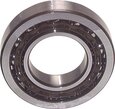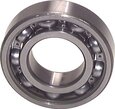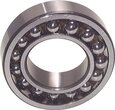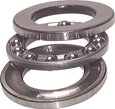Self-Aligning Bearing Guide And Overview
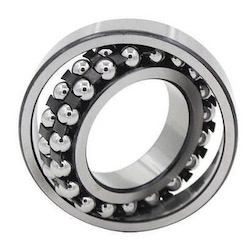
Figure 1: Self-aligning bearing
Self-aligning ball bearings are ideal for applications with misalignment issues between the shaft and housing. Due to their design, self-aligning ball bearings can accommodate up to 3° of misalignment without increasing the amount of friction and frictional heat produced. However, as the contact angle is relatively small on these bearings, the axial load capacity is not as high as, for example, angular contact bearings. These bearings can handle both static and dynamic misalignments. A sealed self-aligning ball bearing also protects it from dirt and other contaminants. Self-aligning ball bearing applications can be found in various industries, such as mining, food processing, and mass production use, such as the textile industry.
Table of contents
- Self-aligning ball bearings construction
- Advantages and disadvantages
- Mounting a self-aligning bearing
- Selection criteria
View our online selection of ball bearings!
Self-aligning ball bearings construction
Self-aligning ball bearings consist of an outer ring, an inner ring, rolling elements, a cage to house the rolling elements, and seals that protect the balls from contaminants and other dirt. Due to their design, these elements make it possible for self-aligning bearings to counteract any static or dynamic misalignment of a shaft and housing assembly up to 3°. They also generate far less heat than other bearings due to the low friction within the bearing, allowing them to run cooler than other bearings at higher speeds. Self-aligning bearings work by utilizing a design with two rows of balls or rollers separated by a spherical raceway.
- Outer ring: The outer ring of the bearings has a smooth spherical shape without raceways. The shape of the outer ring allows for slight movement within the bearing, which in turn allows the bearing to self-align.
- Inner ring: The inner ring of the self-aligning bearing has two raceways that keep the balls and cage in place.
- Rolling elements and cage: The rolling elements on self-aligning ball bearings are kept in place by the cage and the inner ring. As there is a loose configuration between the balls and the inner and outer ring, friction and frictional heat are very low. The cage is typically stamped steel, PA66, reinforced glass fiber, or machined brass.
- Seal: A sealed self-aligning ball bearing ensures dirt and other contaminants don't affect the bearing rolling elements.
Advantages and disadvantages
There are many advantages of self-aligning ball bearings over other bearing types, such as tapered bearings, deep groove ball bearings, and other ball bearing types. However, self-aligning ball bearings do not perform as strongly in terms of load-carrying capacity.
Advantages
- Misalignment: Self-aligning ball bearings can counteract static and dynamic misalignment of up to 3°.
- Service life: These bearings offer excellent high-speed performance and generate far less heat and friction than other ball bearing types. This allows them to run cooler and extends their service life while reducing maintenance.
- Light load performance: This type of bearing has very low load requirements, which means they perform excellent, even under light loads.
- Low noise: Self-aligning ball bearings produce low noise levels due to the loose conformity between balls and the outer ring. This makes them especially suited for use in household items such as fans and air conditioning units.
Disadvantages
- Load types: The ball bearings on self-aligning ball bearings are mounted at a relatively straight angle between the inner and outer ring. This means that the load types the bearing can handle is radial, with little axial load carrying capacity.
- Load amount: As ball bearings have a small point of load-bearing contact, the amount of load this type of bearing can handle is relatively small.
Mounting a self-aligning bearing
Most self-aligning ball bearings will be mounted using an adapter sleeve. In the below steps, we explain this procedure:
- Bearings often come with a protective film that protects the components from outside influences during transport. Make sure to remove this film before mounting the bearing
- Oil the exterior surface of the bearing with oil or grease.
- Apply oil to the adapter.
- Open the adapter slightly with the help of a screwdriver and slide it in place on the shaft.
- Once the adapter is in the correct position, position the bearing on the adapter sleeve. If the shaft has threads, it will help to use a nut to bring the bearing in the correct place; if not, use a bearing pusher kit or a small mallet.
- Once the bearing is in place, test the rotation of the bearing on the outer ring. It should be able to rotate freely, but not swivel.
- Lock the bearing in place with a locking washer by first removing the nut, placing the washer in place, and putting the nut back again.
Note: If the adapter sleeve is loose or not properly secured in place, the inner ring can start turning on the adapter sleeve. This causes excessive friction between the three components and can damage the shaft, adapter, and bearing.
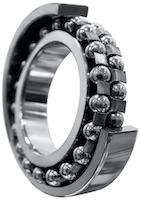
Figure 2: Mounting a self-aligned bearing ball-bearing-self-align.jpg
Selection criteria
When selecting self-aligning bearings, the primary considerations revolve around any possible alignment problems, rotational speed, load type, load size, tolerances, and bearing dimensions:
- Misalignment: The choice for self-aligning bearings often comes down to necessity. When an operation suffers from possible shaft misalignment, the option for a self-aligning ball bearing is clear. Remember that most self-aligning bearings can handle misalignments no more than 3°. Anything higher than this would require unique designs.
- Speed: The speed self-aligning bearings can operate at is significantly higher than most conventional bearings. A self-aligning bearing is a good choice if you need a high-speed bearing. However, speed also depends on the lubrication type and bearing size. Therefore, it is also important to consider your operational speed requirements, desired lubrication type, and required load capacity. Lubrication with grease has a slower operating speed than lubrication with oil. More information can be found in our tribology series of articles and our bearing lubrication article.
- Loads: Self-aligning bearings are well suited for radial loads but less suited for axial loads due to their slight contact angle. Keep this in mind when choosing a bearing.
- Lubrication and seal type: Generally, there are three possible lubrication options: relubrication, typically with an open or shielded seal; pre lubrication, typically with a closed seal; or solid lubrication, typically with a closed seal.
- Dimensions: Select the bearing size according to the speed requirement, type of load, amount of load, shaft size, and housing size




